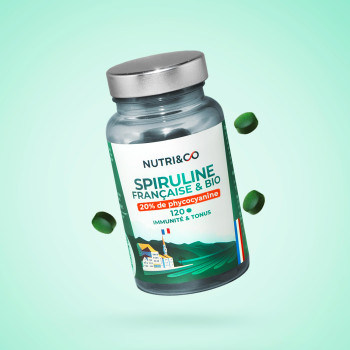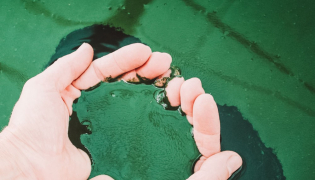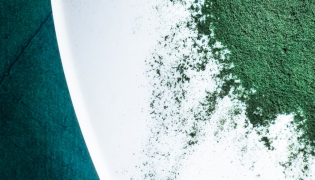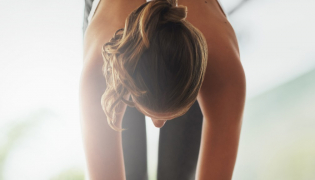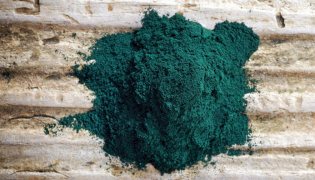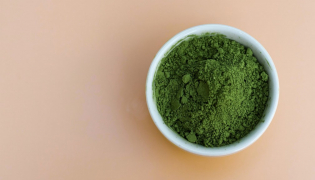
WHAT TO REMEMBER :
- Spirulina develops in tropical climates: France cannot cultivate it all year round.
- Prices are thus 4 to 5 times higher than those of southern spirulina.
- However, its quality does not exceed the world average.
Naturalia, Bio C'Bon, Biocoop or La Vie Claire... French spirulina have invaded the shelves of organic brands ! But what are they really worth ? Who produces them ? And why is it that a brand that promotes Made in France such as Nutri&Co is not the first ambassador for it ? We explain everything to you !
Prohibitive prices
That is a fact, spirulina does not come from our temperate regions (1). To be bursting with nutrients and multiplying, it requires a climate that only tropical regions are able to offer. Thus, when the best located farms cultivate algae all year round with an average yield of 12gr/m2/day (2), French producers have only 9 months and only reach 15gr/m2/day a few days a year (the average would be around 2.5g/m2/day) (3). To continue production in winter, heating and lighting are necessary, generating considerable additional costs. It is therefore not surprising that significant price differences appear with a French spirulina trading 4 to 5 times more expensive than its tropical cousin.
What about the cost of labour then? Not really... spirulina cultivation is not labour-intensive, it is what allows Californian and Hawaiian farms to align themselves with so-called "tropical" prices.
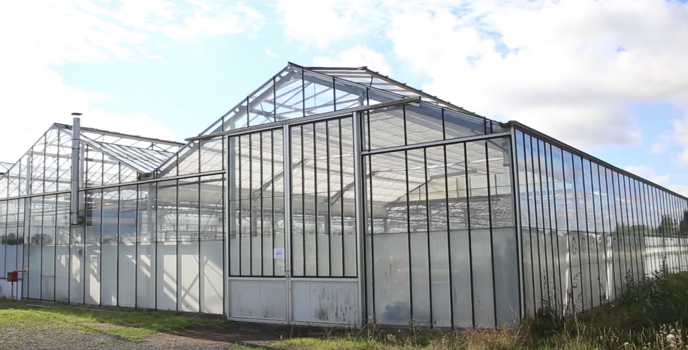
Located in Rochefort, Charly Margain's pilot farm probably produced the most qualitative algae in France with its 22.15% phycocyanin (4). However, these basins changed ownership at the end of 2015 (5).
Overvalued quality
A tenacious idea would be that our producers would be the only guarantors of quality in the face of the steamroller of large Asian farms. But at Nutri&Co, we believe that this is a myth...
Whether the purists of 100% Made in France like it or not, Asian countries have been interested in spirulina since the 1970s(6)(7). Phycocyanin has been studied in them since the early 1990s(8). We are counting the patents in microalgae cultivation, Japan, China and India are 30 years ahead of us. To say that 100% of their production is of dubious quality would be clearly exaggerated. As everywhere, there is good and not so good.
On the other hand, the grown in France is not necessarily a guarantee of quality. In terms of cleanliness, cases of high heavy metal content have already been reported, and like all farms in the world, sometimes a pond can be contaminated (9). On the nutritional level, the very high phycocyanin contents (18-22%) remain rare and come from pilot sites with a low capacity (10). The average is more in the region of 12%. It should also be noted that as of the date of this article, only one French farm has been certified organic (AB), Cyane located in Brittany, near Quimper.
While it is true that French basins remain small for the time being, two industrial units have been created: Cyane in Brittany with its 30 tonnes of annual capacity and Algae Natural Food in Alsace(11). Contrary to our 2017 analysis, where we estimated that these mastodons would quickly take up three-quarters of French production, it would seem that small farms still dominate the French landscape to a very large extent.
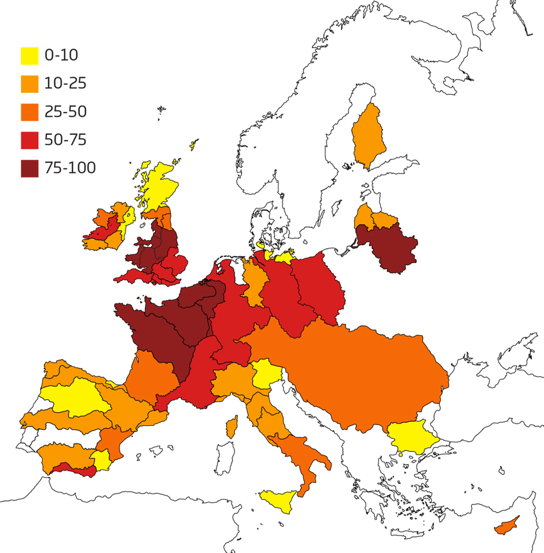
On this map, the figures correspond to the percentage of sites in each river basin where pollution levels are non-lethal but can cause long-term damage.
Our arbitration
Faced with a price varying from a simple to a quadruple without qualitative justification, what can we do? We have opted for the most economical consumer solution, especially since grown without lighting or heating, our spirulina has a neutral carbon footprint, despite its importation (13). In addition to 35 years of experience, our Indian producer is the first to have developed a 100% organic crop.
And then rest assured, our spirulina has been screened according to French health safety rules: control of the announced contents, bacteriological analyses, heavy metals and pesticides, our packaging laboratory is ISO 22000 certified in order to guarantee you an irreproachable product! You can find all the analyses on the page of our Spirulina.
(1) However, a Camargue strain was isolated by Gilles Planchon in 1996.
(2) MicroAlgae Production Processes, Normal yields of outdoor Spirulina culture ponds (summer versus winter), Georges Bonnin : http://microalgaeproductionprocesses.simplesite.com/433509272?i=147127965 // Echanges avec Imran Pasha, Parry Nutraceuticals, producteur indien de spiruline et fournisseur de N&C.
(3) Analyse de la faisabilité d'un couplage de production de biogaz et spiruline. Etude réalisée pour le compte de l'ADEME par DECID & RISK et ESETA, coordination technique ADEME : Julien THUAL, octobre 2015, page 21 & 34.
(4) Gourmet Spiruline avance 22,15% de phycocyanine dans sa spiruline cultivée à Rochefort avant 2016 : https://gourmet-spiruline.fr/a-propos/jt-de-france-3.html
(5) Connaissez-vous la spiruline, micro-algue maintenant produite à Rochefort ? - 20 octobre 2017 à 6:05 - Par Gérald Paris, France Bleu La Rochelle. https://www.francebleu.fr/infos/sante-sciences/et-vous-connaissez-vous-la-spiruline-micro-algue-maintenant-produite-a-rochefort-1507278866
(6) History of spirulina industry in China : Interview with Hong-Jun Hu, Août 2015, Algea World News https://news.algaeworld.org/2015/08/history-of-spirulina-industry-in-china-interview-with-hong-jun-hu/ Le professeur Hu est considéré comme le père de la spiruline en Chine. Il commence à l’étudier dans les années 70 lorsqu’il soutien sa thèse.
(7) Parry Nutraceuticals Organic Spirulina Manufacturing Process, film promotionnel, Youtube, juillet 2016, 1 minutes et 15 secondes.
(8) Zhang Cheng-Wu et al. April 1994. Pub. In Proc. of Second Asia Pacific Conf. On Algal Biotech. Univ of Malaysia. P.58. China.
(9) Il nous est difficile de donner des sources sans risquer de crisper les tentions. Cet article n'a pas pour but de discrédité la filière française, mais de la relativiser face aux fermes tropicales trop souvent décriées. Nous invitons le lecteur à effectuer ses propres recherches sur Internet pour trouver des éléments au sujet des lots français parfois contaminés.
(10) La capacité moyenne d'une ferme française reste inférieur à une tonne. Analyse de la faisabilité d'un couplage de production de biogaz et spiruline. Etude réalisée pour le compte de l'ADEME par DECID & RISK et ESETA, coordination technique ADEME : Julien THUAL, octobre 2015, page 21.
(11) En juin 2019 Algae Natural Food est entrée en liquidation judiciaire. Nous soutenons Francis Kurz, son fondateur, qui partage notre vision de la transparence et de la qualité : https://actulegales.fr/recherche/siren/801343062
(12) Ralf Schäfer and al, Universtié de Coblence, Allemagne, 2014. L'étude mentionne plusieurs pesticides, antibiotiques, désherbants, insecticides et antifongiques.
(13) Les algues à l'assaut du réchauffement climatique, Les Echos, Richard Hiault, septembre 2019. https://www.lesechos.fr/idees-debats/editos-analyses/les-algues-a-lassaut-du-rechauffement-climatique-1133879 . En effet, la spiruline est capable de produire plus de 16 tonnes d’oxygène, par hectare et par an, et de capter 23 à 40 tonnes de CO2. C’est 6 à 10 fois plus qu’un arbre. Ce dernier en capte maximum 4 tonnes dans les mêmes conditions. La culture de spiruline à grande échelle pourrait être une solutions pour lutter contre la pollution sur la planète et permettre un rééquilibrage O2/CO2.

